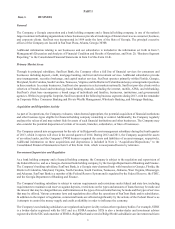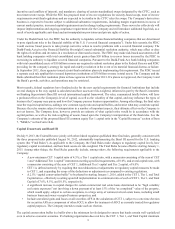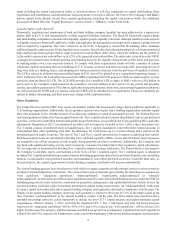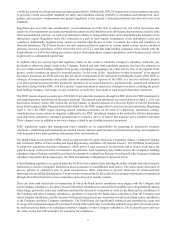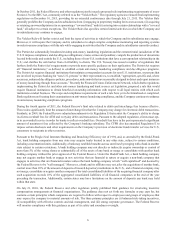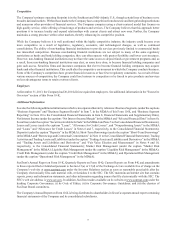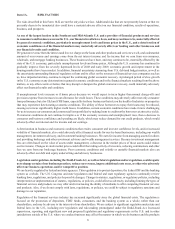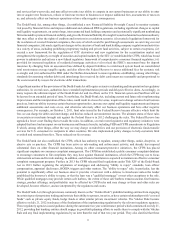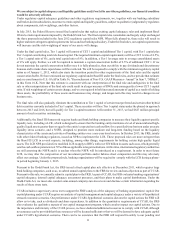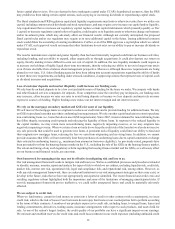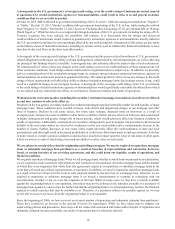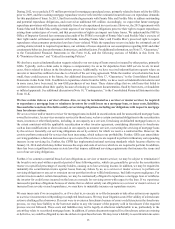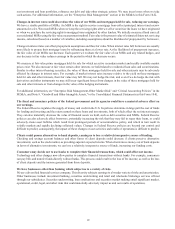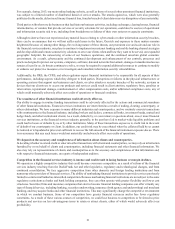SunTrust 2013 Annual Report Download - page 27
Download and view the complete annual report
Please find page 27 of the 2013 SunTrust annual report below. You can navigate through the pages in the report by either clicking on the pages listed below, or by using the keyword search tool below to find specific information within the annual report.11
We are subject to capital adequacy and liquidity guidelines and, if we fail to meet these guidelines, our financial condition
would be adversely affected.
Under regulatory capital adequacy guidelines and other regulatory requirements, we, together with our banking subsidiary
and broker-dealer subsidiaries, must meet certain capital and liquidity guidelines, subject to qualitative judgments by regulators
about components, risk weightings, and other factors.
In July 2013, the Federal Reserve issued final capital rules that replace existing capital adequacy rules and implement Basel
III and certain requirements imposed by the Dodd-Frank Act. The final capital rules consolidate and largely adopt unchanged
the three proposals included in the June 2012 regulatory capital rules NPR. When fully phased-in, these rules will result in
higher and more stringent capital requirements for us and our banking subsidiary. Under the final rules, our capital requirements
will increase and the risk-weighting of many of our assets will change.
Under the final capital rules, Tier 1 capital will consist of CET 1 capital and additional Tier 1 capital, with Tier 1 capital plus
Tier 2 capital constituting total risk-based capital. The required minimum capital requirements will be a CET 1 ratio of 4.5%;
a Tier 1 capital ratio of 6%, and a total capital ratio of 8%. In addition, a Tier 1 leverage ratio to average consolidated assets
of 4% will apply. Further, we will be required to maintain a capital conservation buffer of 2.5% of additional CET 1. If we
do not maintain the capital conservation buffer once it is fully phased in, then our ability to pay dividends and discretionary
bonuses and to make share repurchases will be restricted. We will be required to comply with the minimum regulatory capital
ratios as of January 1, 2015, which also starts the transition period for other requirements of the final rules and the capital
conservation buffer. We have estimated our regulatory capital under Basel III under the final rules, and we provide that estimate
and a reconcilement to U.S. GAAP in Table 36, "Reconcilement of Non-U.S. GAAP Measures - Annual" in Item 7, "MD&A",
in this Form 10-K. Note that this estimate is consistent with our interpretation of the final rule and ambiguities in the final
rule or other interpretations of the final rule could result in a larger measure of RWAs and consequently a lower CET 1 capital
ratio. If risk weightings of certain assets change, and we are required to hold increased amounts of capital as a result of holding
those assets, the profitability of those assets and businesses may change, and longer-term this may result in changes in our
business mix.
The final rules will also gradually eliminate the contribution to Tier 1 capital of certain trust preferred and certain other hybrid
debt securities currently included in Tier 1 capital. These securities will lose Tier 1 capital status under the phased-in approach
between 2013 and 2016, but will qualify for Tier 2 capital treatment. At December 31, 2013, we had $627 million principal
amount of such securities outstanding.
Additionally, the Basel III framework requires banks and bank holding companies to measure their liquidity against specific
liquidity tests, including a LCR, which is designed to ensure that the banking entity maintains a level of unencumbered high-
quality liquid assets greater than or equal to the entity's expected net cash outflow for a specified time horizon under an acute
liquidity stress scenario, and a NSFR, designed to promote more medium and long-term funding based on the liquidity
characteristics of the assets and activities of banking entities over a one-year time horizon. In October 2013, the FRB, jointly
with other federal banking regulators, issued an NPR to implement the LCR. These proposed rules are more stringent than
the Basel III LCR in several respects, including, among other things, requirements for holding certain high quality liquid
assets. The LCR NPR provides for a modified LCR to apply to BHCs with over $50 billion in assets such as us, which generally
sets the cash outflow parameters at 70% of those applicable to larger institutions. At this time, international regulatory authorities
are still assessing the NSFR and it is unclear when the NSFR will be introduced as a requirement. In order to meet future
LCR, we may alter the composition of our investment portfolio and/or balance sheet composition and this may adversely
affect our earnings. Under the proposed rule, banking organizations will be required to comply with the LCR during a phase-
in period beginning January 1, 2015.
Pursuant to the Dodd-Frank Act, the FRB issued a final capital plan rule effective in December 2011, which requires large
bank holding companies, such as us, to submit annual capital plans to the FRB for review and non-objection as part of CCAR.
Pursuant to this rule, we annually submit a capital plan to the FRB. As part of CCAR, the FRB evaluates banking organizations'
capital adequacy, internal capital adequacy assessment processes, and their plans to make capital distributions. Under the
Dodd-Frank Act, we must also conduct semi-annual company-run stress tests and disclose certain information regarding the
results of these stress tests.
CCAR includes a supervisory stress test to support the FRB's analysis of the adequacy of banking organizations' capital. Our
capital planning under CCAR requires an analysis of capital management and capital adequacy under a variety of hypothetical
stressed economic scenarios. Our performance under CCAR's hypothetical scenarios dictates the capital actions the FRB will
allow us to take, such as dividends and share repurchases. In addition to the quantitative requirements of CCAR, the FRB
also evaluates the qualitative aspects of our capital management program, which can also impact our capital actions. Due to
the importance and intensity of the CCAR process, we have dedicated additional resources to comply with CCAR, although
no assurance can be provided that these resources will be deemed sufficient or that we will be deemed to have adequate capital
under CCAR's hypothetical scenarios. There can be no assurance that the FRB will respond favorably to our pending and


